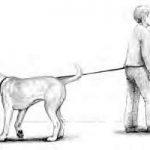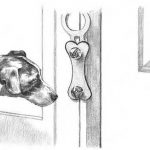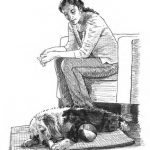In This Chapter
- Giving your dog the lay of the land
- Introducing her to your family and other pets
- Surviving the first night
- Scheduling your life around your new dog
Bringing your new dog home involves more than just leading her through the front door. You want your dog to walk into a loving home where every experience she has is a positive one.
In this chapter, I give you tips on introducing your new dog to the people and animals she’ll be living with. You’ll show your mixed-breed dog where her food, water, and bed are, as well as where she should go to relieve herself.
If your mixed-breed dog recently left her brothers and sisters, or a foster home where she had become attached to someone, she’ll be feeling mighty lonely without her special friends. In this chapter, I let you know what to expect and how to help your dog feel safe and comfortable in her new home.
Finally, you need to schedule time for your new mixed breed. You need to figure out how your new family member fits into your own busy schedule, when and where she’ll get her exercise, what times are good for meals, and when you’ll take her out to relieve herself. In this chapter, I offer some tips on all these topics.
Giving Your Dog the Guided Tour
You want to introduce your new mixed breed to your home — and everything and everyone in it — in a controlled, calm, and loving manner, from the first minute you arrive. Proper introductions will help her settle in faster and feel secure in her new home.
Walking her in and showing her around
If you’re driving your mixed-breed dog home, be sure to put her on a leash and walk her from the vehicle to your door. This prevents her from running off, especially important because she has no idea where she is and could easily become lost (not to mention hit by a car).
The other reason a leash is important is because you want to have some control over where she goes after she’s inside. You want to take each room slowly, so that your dog won’t feel overwhelmed. Here are some basic steps to follow:
1. Walk her into a room.
2. Let her sniff around the room, still on the leash.
3. In each room, tell your dog to sit. If she doesn’t listen, place her into position and reward her so that she learns the meaning of the word, Sit.
4. After she sits, praise her, pet her, and give her treats.
5. Move on to the next room.
Repeat these steps until you’ve gone through every room in your house — even rooms you plan on keeping off-limits for your dog. This approach will help her feel more comfortable.
Tip
Dogs react to the emotions of the people around them. If you remain calm, you’ll help your new dog feel more relaxed.
Put other family dogs outdoors when bringing in your new mixed breed. This will prevent any territorial disputes and help your new dog settle in faster. When she’s comfortable, allow her to meet other four-legged family members one at a time.
Greeting the family
Everyone probably wants to be the first to greet your new dog. But the last thing you should do is let everyone come up at once. Being swarmed by a bunch of strangers is way too overwhelming for your new dog. Instead, make sure that each family member has a treat in hand and then take turns allowing the dog to come and accept the treat. As the dog eats the treat, pet her gently on her chest and talk to her in a happy, calm tone of voice. When your dog is done with the first treat, repeat with the next person until everyone in the family has had a turn. The meeting will be positive, and the dog will learn that everyone in your family is a source of all kinds of love and treats.
Warning!
Always closely supervise children as they interact with your new dog. They need to be taught responsible handling techniques and that the dog should sit for them prior to giving her a treat or petting.
Tip
To a dog, being the source of treats means good things. You definitely get on a dog’s good side through her stomach. Gentle massages are great, too — especially the ears, tummy, and back.
Meeting other pets
Introducing your new dog to your other pets is something you need to put a little thought into. An unplanned introduction can go very badly for the new dog, as well as your other pets.
Warning!
Don’t make the introductions at the same time you enter your home with your mixed-breed dog — it could be threatening to the existing family pets, who may become territorial and assertive. Keep your other animals in a safe area away from where your new dog will be entering and exploring your home.
Tip
Do the first introductions in neutral territory. A great meeting place is anywhere that your current pet doesn’t spend much time, someplace where she won’t feel territorial.
Tip
Introductions to other dogs
The best way to ensure that your new mixed-breed dog will be welcome into a home that already has a dog or two is for you to take your current dogs to meet the new family member prior to bringing her home. If they do well together, then the canine welcoming committee will be more favorable. If not, then you know to not adopt that particular dog.
The best way for dogs to meet is on their own terms. This means off leash (or if you’re unsure, allow the leash to drag) in a safely fenced area where they can greet each other in their own way. You’ll see lots of rear-end sniffing, nose-to-nose sniffing, posturing (walking around stiff-legged, putting a paw over the other dog’s shoulders, or fur raising along the spine, among other things), and maybe some whining, whimpering, or barking.
Regardless of what you see, most dogs work it out well on their own without your help. In fact, getting in the way of this initial canine socializing can cause problems as you aren’t allowing the dogs to do what they need to do to figure out where they stand within the pack pecking order. After the dogs figure out where they stand, one dog will bow down and invite the other to play. Then they’re off and running, lifetime friends.
Warning!
Here are some signs that the dogs may have some difficulty getting along:
– One of the dogs is snarling.
– The dogs rush at each other growling.
– Both dogs posture and try to get on top of each other.
– One of the dogs shows complete disinterest and tries to walk away, but the other dog persistently tries to gain that dog’s attention. This might happen if one of the dogs is very old and has no interest in playing with another dog, but the other dog wants very much to play. The older dog may snap or injure the persistent younger dog. Or the younger dog may inadvertently injure the older dog.
– The dogs stare at each other for a long time, challenging dominance.
If you notice any of these signs, separate them immediately.
A good means of acclimating dueling dogs is to walk them together. Initially, have one person walk one dog and another person walk the other dog. Walk the dogs side by side, but make sure the dogs are separated by one or both of the people. When both dogs are paying more attention to their people than to each other, you can bring them closer together while walking.
When the dogs can walk in the same direction together, they’ll need to learn to pass each other. Start them at a distance where the dogs don’t react to each other. Each time the dogs can pass each other without reacting, bring them a little closer together on the next pass by.
When both dogs are working well together, they can have the freedom to play together in a neutral area, such as a park or down the road from your house. However, if you’re still uncomfortable with allowing the dogs to interact, or you see something in their actions that is bothersome, contact a professional dog trainer or animal behaviorist right away. It never hurts to get a second or third opinion on the dogs’ interactions.
Projecting a positive attitudeWhen you’re helping two dogs acclimate to each other, keep your emotions in check. In order for the dogs to gain comfort, you need to remain passive yet positive about the situation. Your first dog will be directly affected by your emotions, showing edginess if you’re pensive, or aggression if you’re totally scared of the two dogs getting together. The new dog will quickly pick up on this negative energy flowing from you. Keeping your thoughts — and your energy — positive will help the two dogs acclimate to each other quickly. |
Introductions to cats
Introducing your new dog to a cat can be dicey — some cats won’t be as open to greeting your new mixed-breed dog as the dog is to saying hello, often with enthusiasm, to a running, screeching cat. If your mixed-breed dog believes cats are there to be chased, their relationship will be off to a rocky start.
Techniacal Stuff
All meat-eating animals have a prey drive, a desire to hunt that’s triggered by something (or many things). For dogs and cats, movement is one of these triggers; scent comes in a close second. Most dogs chase cats merely because they move (usually running away from dogs). The dog isn’t chasing the cat because she’s hungry — the movement merely triggers the dog’s instinctual desire to hunt.
You have to quickly let your dog know that the cat is supposed to be a friend, not prey. In order for the dog to get the message, you have to keep the cat still during the initial introduction. Have someone hold your cat as you introduce your mixed-breed dog to her. Here’s how to hold your cat:
1. Hold her paws in your hands.
Front paws in one hand, rear paws in the other.
2. Place one arm around the cat’s haunches to control movement of her back end. Place the other arm around her shoulders for control of the front end.
3. Sit and keep your kitty on your lap, holding securely.
When you’re ready to introduce your new dog to your cat, follow these steps:
1. Put your dog on a leash.
2. Allow your dog to push her nose at the cat, with a loose leash.
As your kitty remains still, your mixed-breed dog’s prey drive will not be initiated.
3. Offer both the dog and the cat some tasty treats.
This will make the experience of meeting each other a more positive one. It will give them both good associations in each other’s presence.
Don’t let go of the cat until your mixed-breed dog begins to lose interest and turns away. Instead of just letting go of the cat, place her in another room. This will ensure that she doesn’t run and trigger your dog’s prey drive.
It may take several such meetings in order to ensure that the two creatures become friends. However long it takes, the time spent is well worth it. Not having to separate your pets and teaching them to be comfortable together not only gives you less to worry and fuss about, but also gives them the chance to be companions instead of enemies.
Feline/canine companionship rarely entails the rough play that you see between dogs. It’s more of a comfort level in each other’s presence.
Taking her out to do her business
Shortly after introducing your dog to your house, your family, and your other animals, you’ll need to show your new dog where she should do her business.
Because your dog is new to your household, you need to go with her to show her where to relieve herself. Just letting her out the door might make her uncomfortable. She’s not yet familiar with the yard and she’ll want to come back inside with you, where she may potty on the floor — not the behavior you were looking for.
Instead, take her to her potty zone — on a leash if your yard isn’t fenced. Have some treats with you. Wait with her as long as it takes for her to relieve herself. Your dog has been busy with all the activities, so you can be sure she has to go. Walk around a bit with her, allowing her to sniff. Make certain the leash is very loose at all times.
Tip
When your dog does her business, praise her enthusiastically and give her treats. This positive reinforcement tells the dog that you’re happy that she relieved herself outside, in the area you want her to do her business.
Until your mixed breed is familiar with the yard, you’ll need to continually accompany her to the relief zone, giving treats the moment she does her thing.
Techniacal Stuff
Many dogs, especially those new to a pack, will follow the behavior patterns of the established pack. This helps them be accepted by the other dogs and, even better, learn the house rules faster.
Showing the dog her sleeping area
In order to feel at home, your mixed breed will need to know where to sleep. After all the commotion of introductions and being walked around on the leash, she’ll be very tired. Before leaving your dog to her own devices, show her where you’d like her to rest.
Place her bed in a quiet area, offering safe containment. This can be an alcove with a baby gate separating it from the rest of the house, an exercise pen, or a crate (see Chapter
Housetraining).
Prior to placing your dog in her area, put fresh water within easy reach and include at least three toys along with a comfortable bed.
Remain with your new dog for a few minutes. Remember: You’re her source of comfort. Show her the toys — interact with her and the toys to increase her interest in them. Stroke her gently and speak in a soothing tone of voice. All these things will help your dog relax.
Tip
You’ll know you can leave her in her room when:
- She lays on her hip.
- Her head lowers.
- Her breathing is calm and slow.
Toyland: Choosing the right toysSo many toys, so little time. You really won’t know which toys your dog likes until you’ve tried a few of them and gauged her reaction. Some dogs merely mouth their toys while others demolish them. The safest bets are heavy-duty toys that you can fill with food treats — such as sterilized hollow shank bones, Kong toys, Buster Food Cubes, and others along those lines. A delectable toy will maintain your dog’s attention, preventing her from using her bed or your walls as chewing outlets. Offer a variety at all times. |
If she gets up when you leave (which is a possibility, because her source of comfort is no longer nearby), don’t give in and return. Unless you plan on always sleeping with your dog, she needs to get used to the idea of being alone in her area. Go about your business and don’t look at her. She’ll either turn her attention to the toys or return to napping.
Fighting Those First-Night Blues
Being in a new place with a new family is tough, especially when your dog may have been attached to people or other animals in her last home. The first night in your house may be very frightening — she’s found all kinds of new smells, new people, and new companions. It’s a lot to take in all at once. Where’s the dog she used to cuddle with? What are all those new sounds?
It may take a day or two for your new mixed-breed dog to acclimate to her new home. Until then, you need to understand why she’s unable to relax and figure out how to help her.
Whether you got your mixed-breed dog from a breeder, picked her up from a rescue group, or adopted her from a humane society, she was probably living with other dogs (or puppies) and had formed a relationship with them. Dogs are pack animals, social creatures. They want the company of other canines and they’re very lonely when they’re separated from them. Your new mixed breed will likely miss her former friends until she feels at home with you.
This situation can be far different if you already have another dog, as long as the other dog has accepted your new dog and is willing to allow her to remain nearby at night. However, if your new dog isn’t readily accepted as part of the pack, she’ll likely pace, whine, and scratch to get to you.
The first tendency of new dog owners is to take their anxious dog into bed with them, thinking this is the best way to alleviate the poor dog’s insecurity. Unless you’re planning on always doing this, don’t. Yes, your dog might sleep better, but you’ll regret it later if you really want her to sleep somewhere else.
Warning!
Allowing your dog to sleep with you is setting a precedent for the future. Your dog learns that whining and scratching will earn her a place in the preferred bed. Plus, this will make her feel empowered, in control of the family instead of merely a family member. This situation can be a dangerous one for a mixed-breed dog with dominant tendencies.
The first night may be difficult for both of you, but setting the house rules early in the game will help your new dog learn her place within your family and home. She’ll settle in faster, learn her role, and discover the difference between right and wrong.
Tip
Here are some things you can do to help your new mixed breed dog settle in:
– Sit with her a while at her bed, massaging her chest, back, and ears.
– Keep the lights turned low, not off.
– Try to avoid sharp noises.
– Give her herbal remedies such as valerian root or chamomile tablets an hour before bedtime to help her relax. You can find these at nearly any store that sells vitamins.
– Flower remedies such as Equilite brand, Home Sweet Home, or Bach Flower Rescue Remedy (see Chapter Hup, Two, Three, Four: Good Manners and Basic Training) are great for helping your dog settle into her new home. You can obtain these online or at many popular pet stores.
Tip
Before putting her to bed give her lots of exercise. A tired dog doesn’t have the energy to stress.
Scheduling Time for Your New Dog
You got a dog to enrich your life. Your new mixed breed gives you joy and is something you look forward to each day — and you need to be the same for her. You have to make time for her — time for exercise, specific feeding and relief schedules, and an education (see Chapter
Hup, Two, Three, Four: Good Manners and Basic Training).
Tip
When you make a schedule stick to it. Dogs are creatures of habit. Knowledge of what’s going to occur, and when, helps your mixed breed dog adjust to her new life quickly.
Exercise and playtime
Exercising your dog is just as important as feeding her. Set aside time each day to play with your dog and work with her.
The amount of exercise she needs depends on her age, her breed mix, and her personality. But you can be certain that without enough exercise, she’ll engage in the wrong activities — both to get your attention and to occupy her time.
Walking along on a leash does is great exercise, especially for an older dog, but younger dogs need more than this.
Though training exercises do stimulate your dog’s mind, and make her tired, they don’t totally exercise her body. Dogs need free play — off leash, preferably with other dogs, provided they haven’t ever displayed any aggression to other canines.
A small dog will often get plenty of exercise racing around the house, but that isn’t the preferred situation for a medium-sized or large dog. Having an 80-pound dog racing around an apartment or even a good-sized house can be quite disruptive. More so as she jumps over the couch, runs through the kitchen, and barrels over a trash can or two. Having any dog larger than 10 pounds means lots of exercise — outside, in all types of weather.
A fenced yard will help, but your mixed-breed dog will prefer to spend much of her exercise time interacting with you, such as going for long walks, and playing fetch and chase games. Make time for this.
Feeding time
Dogs need to know when they’re going to eat. Feed your mixed breed in the same location every time so that she knows where she’ll be eating. This will help prevent her feeling that she can eat anywhere in your home, which can set her up for future anxiety (see Chapter
Tackling Mixed-Breed Training Challenges).
Your mixed-breed dog’s feed dish should be somewhere in the kitchen, but not in a direct path with your cooking area. Under a desk, at one end of a kitchen island, or at the edge of the room are generally good places. Place the water dish near the feed dish.
Warning!
Don’t place the dog’s dish near a trash can. She might think the can is part of her meals.
Stick to a feeding schedule to help your dog know that she’ll be taken care of at a specific time. The feeding times depend greatly on your own work schedule, as well as the age of your mixed-breed dog.
Let’s say you work a regular 9-to-5 job. In order to give your mixed-breed dog time to exercise and relieve herself before and after work, try the following scheduling:
6 a.m. Take her to her relief zone.
6:15 a.m. Feed her.
6:30 to 7 a.m. Take her to her relief zone and exercise her a bit before leaving for work.
5:30 to 6 p.m. Take her to her relief zone.
6:15 p.m. Feed her.
7 p.m. Take her to her relief zone and exercise her a lot.
What about if you work irregular hours? Regardless, try to stick to some semblance of a schedule. You may not be able to offer consistent exercise times, but you do need to offer similar feeding times.
Due to their faster metabolism, young dogs need to be fed more often than older dogs. Here’s a sample feeding schedule for a dog under 5 months of age for someone who works the regular 9-to-5 job, keeping in mind that there will be an opportunity for the youngster to eat and exercise midday — whether you can come home at that time, or have someone do it for you, it’s an important consideration when bringing home a young dog.
6 a.m. Take her to her relief zone.
6:15 a.m. Feed her.
6:30 a.m. Take her to her relief zone and exercise her a lot.
12 p.m. Feed her.
12:15 p.m. Take her to her relief zone and exercise her a lot.
6 p.m. Feed her.
6:15 p.m. Take her to her relief zone and exercise her a lot.
Dogs over 5 months of age can safely be fed twice a day, as long as they don’t have a medical condition that requires the dog to be fed smaller meals more often (see Chapter
First Aid: Dealing with Emergencies).
Potty time
Potty time goes hand in hand with feeding time, because when your dog eats has the most bearing on when your dog needs to go out (see the preceding section). If you want a housetrained dog, you’ll have to adhere to a schedule. Make certain you schedule her potty breaks into your day or arrange to have someone available to do it for you.
The younger the dog, the more often she’ll need to potty. This is something to keep in mind when you choose a dog. Do you have the time to take her to her relief zone every hour or so? If you want to housetrain a puppy (see Chapter
Housetraining), that’s what you’ll have to do.
Remember
The more your pup exercises, the more often she’ll need to be taken to her relief zone.
Dogs over the age of 4 months can hold themselves longer, but they still require relief times more often than a dog over 9 months of age. Take your 4- to 9-month-old dog out every three to four hours to be on the safe side. After the age of 9 months, you can wait as long as 6 hours, longer if she has to, but that wouldn’t be kind to her on a daily basis.
Technical Stuff
Male dogs require more time to relieve themselves because they have the tendency to urinate several times instead of letting their bladders empty all at once. They also have to relieve themselves more often throughout the day than most female dogs.
by Miriam Fields-Babineau


































